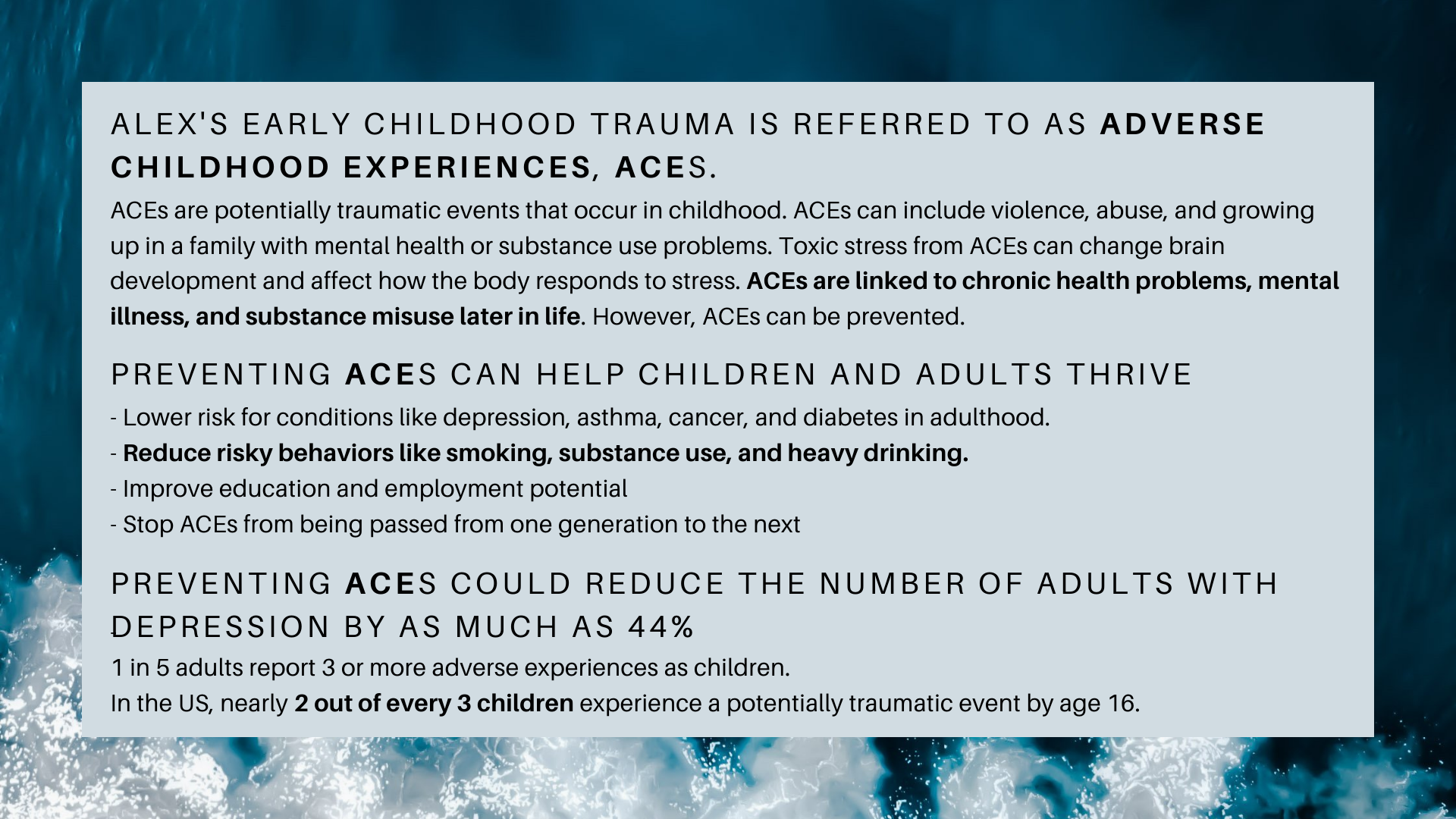
Why?
“The question is not, why the substance, the drugs, or the addiction. The question is, why the pain?“
- Gabor Mate, M.D., Author of In the Realm of Hungry Ghosts
Adverse Childhood Experiences (ACEs)
This powerful Ted Talk about ACEs by Dr. Nadine Burke, pediatrician and former Surgeon General, opens our eyes to the pervasiveness of toxic stress and its damaging life-long effects.
What We Can Do:
“Experiences of trauma are pervasive, but toxic stress is a treatable health condition and it is critical to focus on strategies such as the California ACEs Aware Initiative to build individual and collective resilience and resilient communities.” National Governor’s Association, about California’s ACEs Initiative Case Study, Oct 18, 2021. Access this case study here
Educate ourselves and others about ACEs and how to build resilience. *
Advocate for State and local resources to hire more trained helping professionals. *
Advocate for trauma-informed trainings for all school staff and for implementing trauma-informed district-wide policies and programs. *
Advocate for better healthcare and mental health services for children and families in our community. Increasing access to programs that enhance parents’ and youths’ skills to handle stress, resolve conflicts, and reduce violence. *
* for more information, see the Exploring Solutions tab.
For more information about ACEs, visit Adverse Childhood Experiences (ACEs) | VitalSigns | CDC
The CDC-Kaiser Permanente Adverse Childhood Experiences (ACE) study is one of the largest investigations of childhood abuse, neglect, household challenges, later-life health and well-being. Access it here.
More information about the study can be found in the article, Relationship of Childhood Abuse and Household Dysfunction to Many of the Leading Causes of Death in Adults - American Journal of Preventive Medicine (ajpmonline.org)
Video Resources:
We Can Prevent ACEs - 4 min 30s
Dr Bruce Perry - Early Brain Development: Reducing the Effects of Trauma - 20 min 30s
“ACEs is the single greatest and unaddressed public health threat facing our nation today.”
— Robert Block, MD, Former President of the American Academy of Pediatrics
For information about data, please visit Marin HHS Substance Use Services Strategic Prevention Plan 2020-2025
To learn more about the childhood trauma crisis, visit these links to Part 1 and Part 2 of PBS NewsHour’s “Invisible Scars.”
Marin Specifics:
Wealth Culture:
excessive pressure to achieve
lack of adequate social and emotional support as well as parenting guidance
early peer orientation
entitlement mentality can lead to greater risk taking
social modeling, kids copy cultural belief
overemphasis on academic performance - fear of failure
competitive social structure, “keeping up with the neighbors”. Read more about the impact of wealthy culture here
Easy access of substances of all sorts, including from family’s cabinet, online resources and peers. Read more here Easy Access to Drugs or Alcohol in Teen Years May Increase Risk of Later Substance Use - Partnership to End Addiction (drugfree.org)
Casual perception of alcohol, cannabis and prescription drugs.
Equity Gap: Income gaps from high % of very rich residents to people who live in lowest income ranges, including discrepancies among racial groups. This breeds discrimination, poverty, homelessness, overall increased inequity, which makes Marin more vulnerable for mental health and overall health challenges with higher risk for substance use.
High divorce rate, which can lead to emotional stress, mental illness, and lack of adequate supervision.
Loss of village structure: fragmentation of districts, 17 public school districts, plus private schools, can lead to a loss of community spirit and deepens divide. (The Marin Magazine edition September 2021 includes a Bay Area Private School Guide. It includes a list of 38 private Marin schools, incl K-8, 9-12 and 53 SF based private schools.)
The California Healthy Kids Survey (CHKS) is the largest and most comprehensive regular assessment of students, staff, and parents to document data on school climate and safety, learning supports and barriers, engagement, as well as youth development, health, and well-being. The data provides insight into the scope and nature of youth behaviors, attitudes, and learning conditions that are providing key information to address substance use prevention efforts by Marin County HHS, Behavioral Health and Recovery Services. Newest data pending.
The CHKS 2015-2017 results for Marin County are available here
View further data here:
Alcohol and Drug Use 2017-2019 All Students
Current Electronic Cigarette Use
Experienced Chronic Sadness and Hopelessness
States epidemiological data on consumption, consequences, prescriptions, and treatment of opioids and related drugs specifically for Marin County. Released March 2018. marin.pdf (urban.org)
“Each single being deserves a life of freedom, not imprisonment through drugs.”
More Resources:
Holding On to Our Kids in a Digital World (neufeldinstitute.org) Digital revolution and its tragic impact
Climate change: Young people very worried - survey - BBC News Planetary anxiety see global youth survey
The Impact of Active Shooter Drills in Schools | Everytown Research & Policy | Everytown Research & Policy Increased rate of violence with active shooter drills in schools and their mental impact on students
ACEs Study Trauma/ACEs such as family dysfunction, immigration, racial inequity, economic inequity, digital world and social media, overstimulation and overload of information, all can lead to drug-seeking behaviors.
Loneliness is an epidemic. “Loneliness and weak social connections are associated with a reduction in lifespan similar to that caused by smoking 15 cigarettes a day and even greater than that associated with obesity.”
Lessons from Iceland: How one country turned around a teen drinking crisis | CBC Radio
Post-Traumatic Slave syndrome P.T.S.S. is a theory that explains the etiology of many of the adaptive survival behaviors in African American communities throughout the US and the Diaspora.
Adolescence and the Reorganization of the brain. See more below.

It takes a village.
- African Proverb
The Teen Brain: Uncovering the Myth
Emerging science has challenged the commonly held view that the adolescent brain development being merely a process of maturation, and that the immature pre-frontal cortex causes the immature behaviors of teens. Rather, the developing brain in adolescence is a vital and necessary developmental change that emerges new abilities. In these extremely important brain-forming years, the nurturing and structured support from the environment, family and school primarily, sets the stage for healthy development. Heightened emotions, creativity, adventure, exploration and risk-seeking thrills, all classic characteristics of a teen, are necessary for the evolving into mature human beings.
“When we embrace these needed changes, when we offer teens the support and guidance they need instead of just throwing up our hands and thinking we’re dealing with an “immature” brain that simply needs to grow up, or raging hormones in need of taming, we enable adolescents to develop vital new capacities that they can use to lead happier and healthier lives.” Daniel Siegel, MD, Author of Brainstorm
Myth No. 1: Raging Hormones Make You Crazy
Myth No. 2: You Just Need to Grow Up
Myth No. 3: Strive for Total Independence
Read more: 3 Common Myths About the Teen Brain - Mindful
“This time of transition in the brain also inspires emotional spark, social engagement, novelty seeking, and creative exploration that can be optimized to empower adolescents to live their lives to the fullest.” Dan Siegel, MD, Author of Brainstorm
Videos for teens or anyone who wants to understand more about the brain:
Teen Brains: Teen Brain Development - 3 min 10s
Brain Pruning Itself: Dan Siegel - "The Adolescent Brain" - 4 min 30s
Why does it matter?
What you do with your mind can alter the structure of your brain. Messing up with the brain while it is forming itself, can have long-lasting impact.
When we understand the development of the adolescent brain, we as parents and teachers will be able to support our kids for optimal development. Instead of enduring those challenging years, the ultimate path for parents is to learn how to nurture, guide and build a strong and loving bond with their teens, in order to support the development of a healthy, integrated brain.
Because risk taking is one way to learn and grow, and a teenage brain reads the thrill as a reward, it can potentially lead to serious substance use, and, addiction. But exploring drugs and substances in today’s world poses high risks. The use of illicit drugs from the black market has become extremely dangerous since we are facing one of the worst drug crimes in US history: fake pills and powders that are laced with fatal doses of fentanyl. Recent data show that in CA, one young person dies from fentanyl poisoning every 12 hours. See more in KNOW Drugs.
The teen brain is going through a period of rapid development where it can learn and expand at an impressive rate, in which teens can learn fast, consolidate information, connect emotionally to others, and define themselves on the way to independent adulthood. All of this impressive learning means that the brain hooks onto ideas fast and hard, and that includes substance use.
“This feeling felt sensation is at the heart of how we can help one another feel seen, safe, soothed and secure. Feeling felt is the basis for secure attachment. It is also the essence of healthy relationships in all domains of our life.” Dan Siegel, Brainstorm
Trauma & the Brain:
When a child experiences a traumatic event, or toxic stress — defined as exposure to frequent/prolonged adversity — the body’s stress response can disrupt brain development. This can lead to underdeveloped neural connections in the parts of the brain required for successful learning and appropriate behavior in school and the workplace. When a child’s brain experiences toxic stress, it releases a hormone that shrinks the hippocampus, the part of the brain where stress is managed and memories and emotions are processed.
MRI studies show that there is less gray matter in the prefrontal cortex in people who have experienced ACEs, which can explain why many individuals with ACEs may have difficulty regulating emotion, struggle with impulse control, and engage in potentially unsafe behaviors.
Early childhood trauma can increase a person’s risk of stress-related disease throughout the course of their life. Some research indicates that the risk of developing chronic illness is higher the more ACEs a person experiences. If you’re interested, take the ACEs Self-Test here.
Why do we get addicted?
“Unless we become fully aware of the drivers of our addiction, we’ll continue to live a life in which “choice” is an illusion.” Gabor Mate, PhD
Addiction occurs when repeated use of drugs changes how a person’s brain functions over time. The transition from voluntary to compulsive drug use reflects changes in the brain’s natural inhibition and reward centers that keep a person from exerting control over the impulse to use drugs even when there are negative consequences—the defining characteristic of addiction.
Some people are more vulnerable to this process than others, due to a range of possible risk factors. Stressful early life experiences such as being abused or suffering other forms of trauma are one important risk factor. Adolescents with a history of physical and/or sexual abuse are more likely to be diagnosed with substance use disorders. Many other risk factors, including genetic vulnerability, prenatal exposure to alcohol or other drugs, lack of parental supervision or monitoring, and association with drug-using peers also play an important role.
At the same time, a wide range of genetic and environmental influences that promote strong psychosocial development and resilience may work to balance or counteract risk factors, making it ultimately hard to predict which individuals will develop substance use disorders and which won’t. Learn more about adolescents and addiction here
A Conversation About ACEs
A conversation about ACEs with experts Dr Nadine Burke Harris and Oprah Winfrey.

“Our culture’s stigmas escape the reality of its very own brokenness at large. Addiction is everywhere, not primarily to be found under the bridges or in the hood, as we are made to believe, addiction is in every day’s tiers of society. We have become a consuming, extracting, digitalized, fast-paced, alienated, disconnected, dis-embodied, and obsessively pleasure-seeking society that suffers from loneliness, illness, and mental health imbalances. When we judge people who suffer from substance abuse, we actually distract from our very own pain, the pain of modern life’s unhealthy happiness-or-want-to-belong-seeking attachments. I believe that, in order to heal our communities, we each need to rise up against the delusion of “instant fixes” for happiness. If we don’t heal our core, we will continue giving away our powers, while becoming more separated from our true essence”.
- Marion Kregeloh




